Using Cartoons to Support Learning Development
Happy New Year All! And a belated thank you to JACQUI BARTRAM from the University of Hull and the Association of Learning Development in HE (ALDinHE), who has prepared this beautiful blogpost for us – and which for many reasons (let’s blame #Brexit) has taken us way too long to publish.
Cartoons are us
Who doesn’t love a cartoon? Anything that looks like it will add a bit of light relief to a subject will usually draw the attention of even the most diligent reader. Cartoons don’t just have to be a bit of fun though. Research has recently suggested that cartoons can enhance learning by creating a more relaxed learning atmosphere that can make new or difficult topics seem less daunting (Rodriguez & Lin, 2016). This is consistent with my own experiences, especially with new students who are intimidated by complex topics such as referencing, criticality or reflection.
Reviewing the literature for my own doctoral research (which focuses on visual literacy and the increased need to develop it within HE now that we live in such a visually dominated society) has not only highlighted the need for students to develop visual communication skills but also for staff to champion images as a valid means of academic communication. The dominance of the written word in HE needs to be challenged if graduates are to thrive in an increasingly visual landscape. Cartoons may be at the lighter end of the visual communication spectrum but they are easy to create, powerful in their accessibility and can be tailored specifically to the audience or point in question.
I draw and use cartoons regularly as part of my work as a learning developer and use them for a variety of tasks which range from the fairly mundane to more challenging projects. For example, I use them to enhance basic communication tasks like the promotion of workshop or webinars:

…or to explain how to make use of our services:

But more importantly, I use cartoons to help explain learning points—mostly via our #TipTuesday strand on our library website but also via simple animated videos that can be used as part of workshops, webinars, online courses etc.
Here are examples of some from my #TipTuesday tweets:
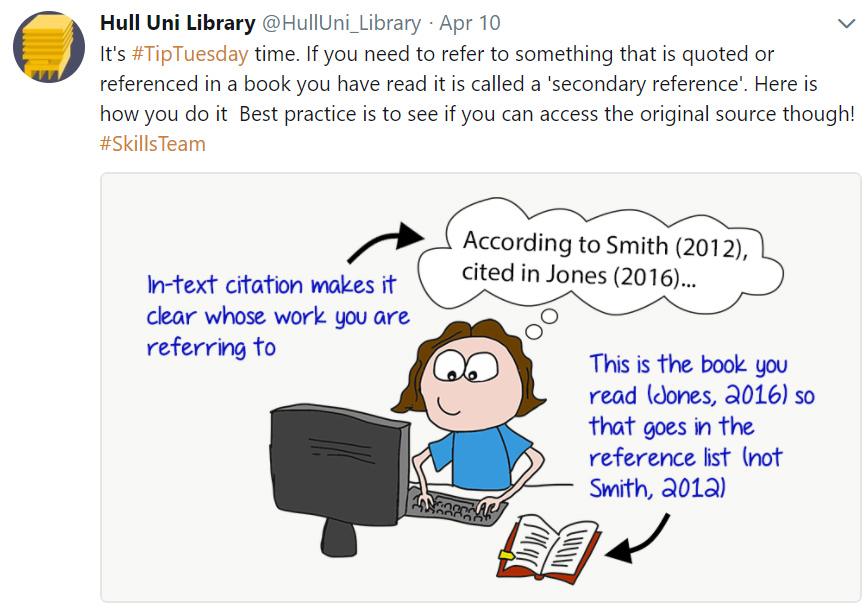
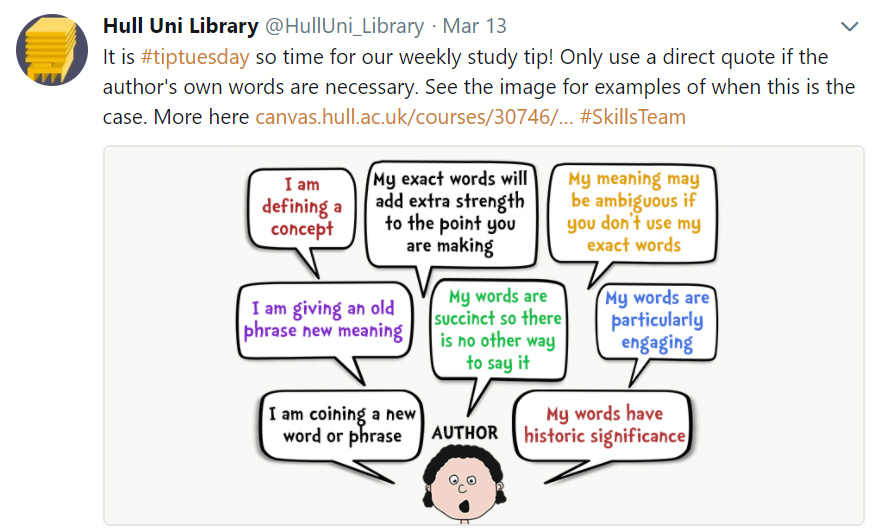


These are often retweeted by academics and other university departments who follow either the library or my personal accounts (I tweet them from both).
You don’t need to be able to draw well
There is a misconception that you need to have artistic ability to be able to cartoon effectively. Yes, your cartoons could be more sophisticated if you are a confident drawer, but that does not mean they will be more effective. Think of the ubiquitous stick figure cartoons of Annie Lawson back in the 1980s (Lawson, n.d.) or Tim Urban’s ‘fantastic Wait but Why’ blog (Urban, 2018). They show that it is more about the idea than the execution.
This point was confirmed when I attended an excellent one day workshop called ‘Cartooning for Communicators’ (which I can thoroughly recommend—you can find out about the next one here http://www.creativityworks.net/training/cartooning-for-trainers/). Although I am a reasonable drawer, the workshop emphasised that non-drawers can produce engaging and eye-catching cartoons that can capture the essence of the subject and message without any artistic skill whatsoever. Most of the attendees did not consider themselves remotely talented artists but soon learned that this was not an excuse to avoid putting charcoal (or later marker pens) to paper. For example, one of the exercises looked at capturing the essence of an animal in order to make it something that is instantly recognisable. Whilst many people initially drew serviceable realistic representations of some basic animals, with the instructor’s help we were gradually able to distil this down to the true essence:
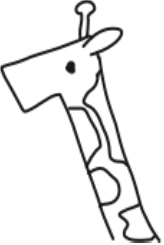 |
 |
 |
| Giraffe – no need to draw the whole animal but the markings and ossicone (the horn-like bit) make it obvious what it is. | Dog – two rectangles with strategically placed triangles and a couple of spots. Truly anyone can draw this! | Pig – even pared back to just the snout with a couple of eyes, most people would recognise this as a pig.
|
The point here is that the human brain is hard-wired to recognise patterns and shapes and identify them as known objects so the cartoonist doesn’t actually need to strive for realism for their drawings to be recognisable—hurray! (This phenomenon is called pareidolia—see Cuánta Razón (2017) for some excellent examples of turning this into an art form.)
Some of my learning development blog posts take this simple drawing style to heart. Here’s an example:
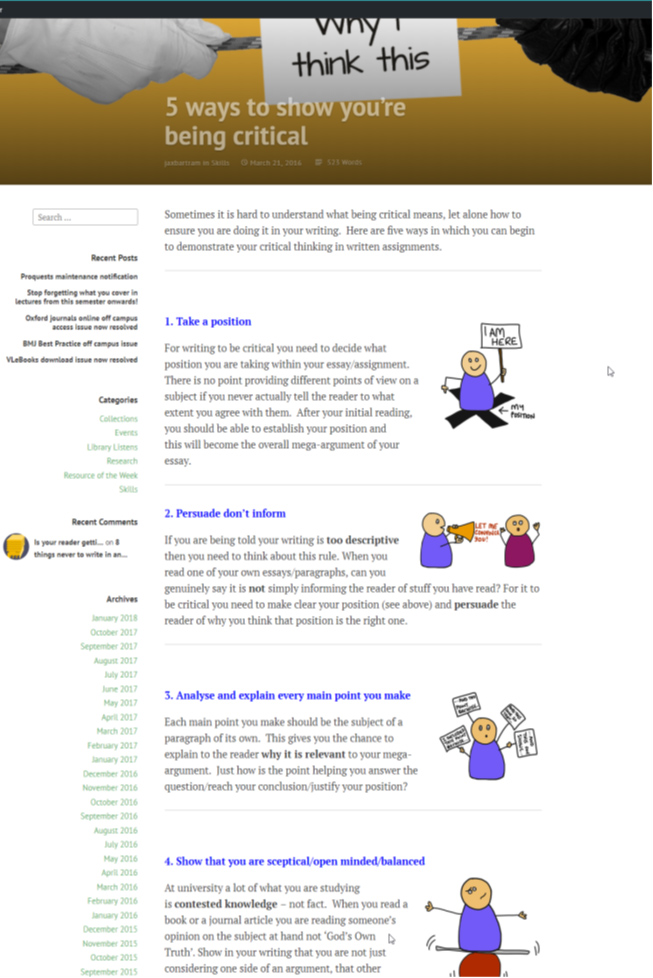
Simplifying concepts
Sometimes students find it hard to understand concepts that we naturally understand and it is difficult to explain that concept in simple enough terms for a student to grasp. Forcing yourself to explain this in cartoon form can be a fantastic way of getting to the essence of what you need to communicate. For example, I have created two videos covering the concepts of Reflective Writing and Critical Writing. These are, I concede, somewhat simplistic—but I make no excuse for this, we use them as introductions to the concepts and the accessibility of the cartoon format has proved extremely successful. You can see these here:
Reflective writing:
[youtube https://www.youtube.com/watch?v=QoI67VeE3ds]
Critical writing:
[youtube https://www.youtube.com/watch?v=btUY6jTt2Ys]
I originally designed the reflective writing sequence to be live-drawn on a whiteboard as part of a workshop. I did this a few times with great response but created the video for when I could not personally attend similar sessions. Since putting it on YouTube, its popularity has snowballed. When I started writing this ‘Simplifying concepts’ section it showed 208,532 views—I came back to it the following day and it was up to 209,213. In fact, if you search for “reflective writing” on YouTube, or “reflective writing video” on Google it is the top result, showing the cartoon format attracts viewers if nothing else.
Cartooning is a wonderful way to make learning development both fun and accessible whilst getting across important concepts—so why not give it a try. Even the simplest stick figures can be effective:
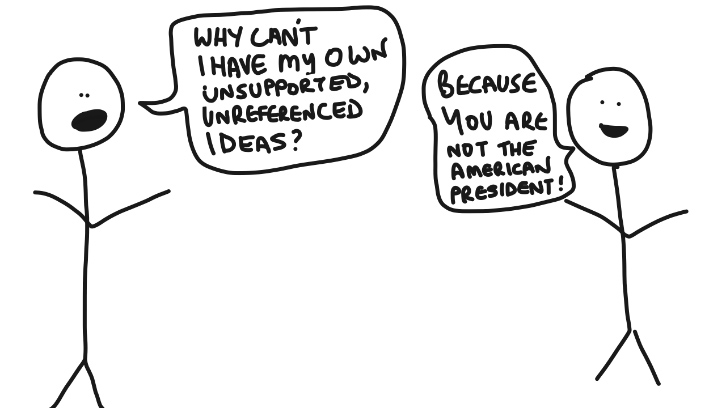
Software
For those who are interested, I create most of my drawings on my iPad using a free app called Adobe Illustrator Draw. This works well for me as I also have the Adobe Creative Suite on my PC and can easily integrate them—but you don’t need to use it with the Creative Suite, it works perfectly well as a stand-alone app. I use a Jot-Pro stylus rather than my finger to draw (I would love an Apple Pencil but I need to update my iPad first). The videos were created using a programme called Videoscribe (available at https://www.videoscribe.co/en/) which costs about £100 per year which I get reimbursed by my library.
References
Cuánta Razón (2017) Pareidolia. Available online: https://www.cuantarazon.com/busqueda/0/pareidolia [Accessed 11/5/2018].
Lawson, A. (n.d.) Annie Lawson and Rug Vision. Available online: http://www.annielawson.com/cartoons.html [Accessed 11/5/2018].
Rodriguez, L. & Lin, X. (2016) The impact of comics on knowledge, attitude and behavioural intentions related to wind energy. Journal of Visual Literacy, 35(4), 237-252.
Urban, T. (2018) Wait but why. Available online: https://waitbutwhy.com/ [Accessed 11/5/2018].
Bio/Blurb
Jacqui is a Library Skills Adviser at the University of Hull where she has the lead marketing role within her team. She specialises in academic communication and supporting students with ICT-based academic study skills. As an EdD candidate, she is researching the development of visual literacy in UK higher education and trying to identify barriers or bridges to its inclusion in curricula. She is co-chair of the Communications and Membership Working Group of ALDinHE (The Association of Learning Developers in Higher Education) and tweets from both @HullUni_Library (with others) and @jaxbartram.

Oh I was waiting for this! Thank you! I was recently inspired by Jacqui’s masterly illustrations to attempt one of my own in a recent conference talk (I wanted to use a still from a film and got cold feet about copyright – so I, uh, ‘reenacted’ it with stick figures). I’m certainly tempted to do more, dreadful artist that I am, and this is really helpful!